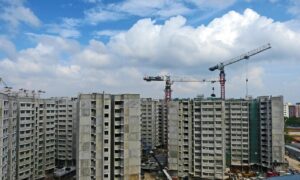Construction projects have many moving parts that must be well coordinated. Without proper planning and execution, projects can quickly fall apart.
How do you ensure you’ve got all your nuts and bolts in place? Through construction project management.
Whether big or small, every construction project can benefit from a solid plan and a great project manager familiar with construction project management.
Project management for construction enables managers to optimize best industry practices, make empowered decisions, and set up effective and transparent reporting methods. This increases the potential for successful project completion—on time and within budget.
In this guide, we’ll explain what construction project management is, the phases involved, its benefits, and the role of project management software in managing construction projects.
What Is Construction Project Management?
Construction project management involves managing various tasks and considerations from inception to execution. Construction projects are complex, therefore, project managers require extensive knowledge of the industry.
The project management goal in construction is to complete projects on time and on budget without compromising codes, plans, and specifications.
Some of the construction project manager’s responsibilities include integrating vendors, tracking budgetary concerns, quality and safety management, and collaborating with a team of specialists.
5 Phases of the Construction Project Management Process
The construction project management process can be broken down into five phases:
Phase 1: Initiation
The initiation phase is a crucial aspect of construction project management. This phase includes three steps that you must take before a project is approved and any planning begins. These steps are:
- Programming and feasibility:In this step, the planning team does a feasibility test and outlines the objectives and goals of the project. In the feasibility test, you look at the goals, cost estimates, and timeline to see if you have the resources to reach a successful project end. Once you decide on this, you draw up a project initiation document (PID). A PID contains essential information like the project’s scope, risks, roles and responsibilities, project plan, and more.
- Schematic design:In the schematic design step, your team creates a sketch showing the space, materials, colors, and textures. This step is necessary because the information collected will inform the design development team on the equipment and materials necessary.
- Contracts:The last step is creating contract documents containing the final drawings and specifications. The contract documents are helpful for project bidding.
This phase is crucial because many unknown variables can appear in a construction project if there’s no clear picture of what the project will look like, how it will get done, and when the team will complete the project. By evaluating all possible scenarios upfront, the client will have realistic expectations that you can deliver.
Phase 2: Pre-construction
Once bidding is complete, and the contractor has been chosen to do the work, you move to the pre-construction phase, which takes place before you break ground. This phase involves putting the project team together. A typical construction project team will consist of:
- Project manager: This is the project leader.
- Contract administrator: Assists the project manager.
- Superintendent: Ensures materials, deliveries, and equipment are on schedule. They’re mainly stationed on-site to handle construction activities.
- Field engineer: Deals with paperwork.
- Health and safety manager: In charge of quality and safety management.
The new team then prepares the construction site before the work begins. Soil testing is necessary to ascertain that the soil is suitable for construction. After the site examination is complete, take your plans and findings for review by the city authorities.
During the pre-construction phase, the project manager oversees proper paperwork management, documentation storage, and control to ensure that the numerous legal issues, permits, and building codes are well handled.
Phase 3: Procurement
You have your team, and your construction site is ready. Next, you need to order, purchase, or rent all the materials, tools, and services necessary to complete the project.
Clear communication is vital in this phase to ensure that teams manage purchases and inventories well. This will prevent your staff from overspending, double-buying, or purchasing outside the project’s requirements.
Phase 4: Construction
Now we’re at the phase where all the planning you’ve done so far will pay off. While the contractor and subcontractors handle much of the work in this phase, the project manager still plays a significant role.
Hold a pre-construction meeting to map out the work schedule, determine where materials will be stored, quality control, and site access. Finally, get everyone to the construction site and set up.
Proper scheduling is vital for this phase to run smoothly. With most construction projects, physical construction occurs linearly, where one construction team has to wait for another team to complete their task. If you schedule work properly, the busy crew members will know what activities they should do for the day. Bad planning and scheduling can lead to project delays and budget overruns.
Phase 5: Close-out
Close-out is the last step in the long process of designing and completing a construction project. After the team completes all the work on the job site, the project will close, and the occupants will move into or take ownership of the site.
In the project close-out, demobilize the resources required for the project, return equipment rentals, clean up the worksite, and reassign subcontractors that have completed their jobs to other projects.
To complete your project management process, carry out a post-project review. The review process will help detect any tasks that teams didn’t complete, analyze any challenges, and provide informative insights for future projects.
Tips for Running a Successful Construction Project
These are some tried-and-true tips for success when managing construction projects:
- Create a proper communication system
Communication is essential to any construction project. Your construction project will have many parties involved. From lead to contractors and subcontractors, architects, vendors, and back-office staff. All these stakeholders need to be updated on the project’s progress.
Create a flow of communication with everyone involved in your project. Communication creates transparency, making the process smoother. It will also reduce phone calls and the number of emails whenever an issue comes up.
One of the most efficient communication systems is project management software that syncs documents, calendars, comments, and photos in a single hub. You can easily monitor updates, budgets, and scheduling changes as they occur and then relay these changes to other managers and accounting offices in real time.
- Maintain proper documentation
Audited documents can help you avert potential conflicts, project delays, or legal issues. But, they’re only helpful if they’re available and accessible. Therefore, it’s vital that you document the project from beginning to end. Documents need to be regularly updated and easy to track. A proper document management system can help you do this and prevent the loss of documents.
- Understand the terms and conditions
Carefully go through the contract document and understand it well before signing it and commencing the project. The contract stipulates the contractor’s and customer’s obligations. When you understand the terms and conditions, you’ll ensure that the project remains within the scope and specifications of work.
- Track resources carefully
Resource management is vital when managing a construction project. Effective construction resource management prevents confusion, shoddy quality, cost overruns, and missed deadlines. It also ensures that you can track resources so that they’re always available to workers when they need them.
- Collaborate and delegate
Managing multiple construction projects alone can be challenging since it involves many moving parts. Keeping track of everything becomes downright impossible. Hence, effective delegation and collaboration are necessary.
When there’s collaboration, one team member may pick up on something another missed. Collaboration also ensures workers don’t make simple mistakes due to focusing on too many things at once.
- Practice continuous planning
Planning in construction projects starts long before actual construction begins and should continue until the project ends. Continue revising and developing plans throughout the project’s design, pre-construction, and procurement stages.
You may do everything right, but plans often change in construction project management, so make planning a continuous process.
- Keep learning about the industry
Construction is a constantly evolving industry. New equipment, practices, safety requirements, and advancements are made every year. To keep up, practice continuous improvement and learning. Familiarize yourself with the construction site and understand the duties of every professional working under you.
- Embrace automated reporting systems
With hundreds of tasks and multiple phases to manage, no construction project manager has the time to reply to hundreds of emails daily or use the phone to call and address every issue that comes up. An automated reporting system can help cut down correspondence.
Automation helps send the correct reports to the right people on time, allowing you to focus on other tasks and communication.
Why Construction Teams Should Use Project Management Software
The construction management process is long and demanding with lots of moving parts regardless of the projects’s size, the number of stakeholders, budget, and delivery date. Having the right project management tool to handle this process is essential. The right software can help you:
Store your data in one place
Project management software makes it easier to record data from the planning phase to the end of the project. The software removes human error from the data collection process. The collected data is stored in a centralized place, making data sharing more accurate and up-to-date. Storing all your data in one place also makes drawing up the schematic design easier.
Schedule better
Scheduling becomes easier and more effective when using project management software. The tool lets you coordinate your team members’ responsibilities around everyone’s schedules. Every team member can see the tasks you assign them and corresponding deadlines.
Track your budgets
A centralized and comprehensive project management solution will help you automate invoicing and billing making it easier to track budgets and combat rogue spending. This seamless budgeting process makes job costing more transparent and more accurate. An effective procurement process can help eliminate delays and budget overruns.
Monitor the construction phase better
Project management tools help the construction manager to oversee quality control, monitor the contractor’s safety program, monitor contractors’ project performance, coordinate technical inspections and permits, and monitor submittals to ensure they are on track.
Real-time communication platforms
Software that supports mobile access is incredibly convenient for construction projects where most people involved are on-site and may not have access to the office server. Such platforms also enable seamless communication between teams at the site and those who aren’t physically present.
How to Use Mission Control When Managing Construction Projects
Mission Control is designed to help managers control every phase of their projects by organizing the various moving parts and automating routines to add efficiencies. It also keeps stakeholders updated by sharing data-rich reports.
The tool has different features that will typically help you do the following:
- Prioritize tasks: The Kanban board allows you to assign tasks in order of priority. Prioritization helps you to ensure that the many jobs involved in construction are all handled in the order that makes the project progress efficiently.
- Track your projects:With a Gantt Chart, you get a visual overview of your project timeline, enabling you to easily track your milestone and see when you’re off track. You can easily see dependencies, allowing you to visualize how each task affects another.
- Manage resources more efficiently: The resource management feature enables you to plan, schedule, and allocate people, money, and technology to specific projects. With proper resource management, you can use your available resources most effectively to achieve the project’s goal.
- Control your budgets: Project financials is a feature that shows you your project’s financial health in the form of charts and graphs. This visual view helps you maintain financial control and visibility in your construction projects.
- Plan better: Mission Control’s project generation launchpad completely streamlines the initial construction project planning process. Here, you can pull out insights and learnings from a previous project and use them to launch better and improved projects.



































